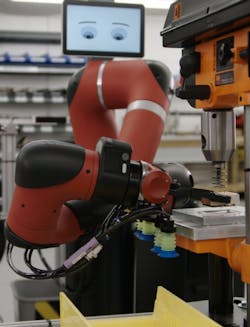Not long ago I wrote a column about choosing between industrial robots and collaborative robots (co-bots) for various manufacturing applications. While speaking with Ryan Guthrie, senior vice president of TM Robotics, for that column, he mentioned that injection molding is becoming something of a hotspot for co-bot applications in industry.
In injection molding operations, “a collaborative robot is used much like a human would be to load or unload an injection molding machine in a repetitive process,” said Guthrie. “The robot takes care of the repetitive part of the operation, leaving the operator to handle the complex part of the operation (in automation terms), such as inspection.” He added that, depending on the application, the cobot’s function could be humanoid, “even to the point of opening machine doors and pressing the same buttons a human operator would.”
After speaking with Guthrie, I learned that Tennplasco, a Lafayette, Tenn.-basedplastic injection molding company that supplies parts to the automotive industry, is using Rethink Robotics’ Sawyer co-bot to address the plant’s labor shortage. In its release about Tennplasco’s application of Sawyer, Rethink Robotics noted that Tennplasco was not only able to solve its labor shortage issue with Sawyer, it also achieved return on investment (ROI) on the co-bot in less than four months.
“Like many other manufacturers, we have been really struggling to get workers in our factory, especially on the off shifts. The truth is, there are not a lot of people in our area looking for injection molding jobs, and if we don’t have people showing up to work, we can’t operate,” said Danny Rose, general manager at Tennplasco. “With Sawyer, we don’t have to worry about whether the shift will be staffed and we can stop wasting our time and effort on trying to recruit non-existent labor.”
Sawyer is currently being used on Tennplasco’s assembly line, helping to assemble and inspect automotive parts.
The video below shows how Tennplasco is using Sawyer in its production operations.
Explaining why co-bots are becoming popular in injection molding applications, Guthrie pointed out that, for manufacturers of low-volume, highly changeable parts, co-bots can be “an ideal automation solution. At a reasonably low cost, the manufacturer gains the advantages of highly repeatable processes and consistent output. And at low speeds, a risk assessment is likely to allow for close collaboration with human workers on upstream or downstream processes without expensive safety guarding. ROI is dependent on how much of a human worker’s processes can be taken on by the cobot; but it's not uncommon for a cobot to replace the equivalent of half a worker or as many as a couple of workers.”
Guthrie also noted that the main challenge in applying co-bots occurs when production volumes increase for a successful product line, requiring a significant increase in speed and accuracy and interaction with other automated processes, or when high rigidity is required, such as with heavier payloads. In high-volume production, “an industrial robot would be integrated into an injection molding line with an emphasis on productivity and cost-efficiency,” he said. For example, a medium-sized six-axis or Cartesian robot can unload the molding machine to a conveyor or single-axis Cartesian, which passes the part onto a SCARA or six-axis robot to carry out another function such as quality control or assembly. “A fully guarded system would allow significantly higher cycle times of up to 120 parts per minute, for an output of more than 63 million parts per year running three, mostly unattended shifts,” Guthrie said.
Leaders relevant to this article:


